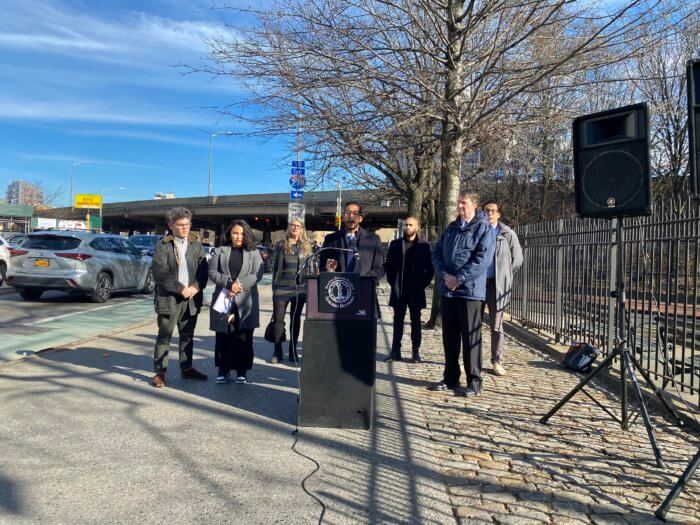A group of activists and elected leaders are blasting the state government for failing to reimagine the Brooklyn-Queens Expressway — saying the contentious roadway has decimated communities of color with heavy vehicle traffic and toxic pollution.
“If we miss this opportunity to address the harms of the past, make no mistake: New York State is to blame,” said Brooklyn Borough President Antonio Reynoso.
Reynoso, along with elected officials from all levels of government, gathered on Monday at the Jaime Campiz Playground in Williamsburg to lament that the state Department of Transportation has “no plans” to make any significant alterations to sections of BQE that run through residential neighborhoods, which they told Streetsblog earlier this month.

Much attention has been paid to one particular portion of the BQE that travels through Brooklyn Heights, dubbed the Triple Cantilever section for its layered design below the local Promenade, as that section is in an alarming state of disrepair and will need to be repaired or risk collapse.
But, north of Brooklyn Heights, where the highway runs through Downtown Brooklyn and Williamsburg, as well as south, which traverses Cobble Hill and Carroll Gardens (before hitting Red Hook and turning into the Gowanus Expressway), there have been no major talks from the state government about re-thinking the roadway.
As discussions of the need for repair to the Triple Cantilever section have heated up, the local leaders have begun demanding even more — pointing out that other parts of the roadway have left mostly-poor, mostly-minority communities reeling.
The raised roadway has had detrimental effects on the immediately adjacent areas, both from a quality of life perspective and in terms of increased pollution (and the health defects that results). Earlier this month, 18 elected officials signed an open letter to the New York State DOT, panning that agency for failing to participate in the city DOT’s “visioning process” to mitigate those harms.
“This historic opportunity to rebuild the BQE extends beyond the Triple Cantilever and our communities deserve a forward thinking vision that redesigns the entire BQE and addresses the significant environmental justice impacts of the thruway,” the letter says. “We ask that the NSY DOT remember the daily harms caused by the BQE in its current state.”
Constructed during the 1940s as the brainchild of Robert Moses, the BQE has been both an eyesore and an impairment to public health in several communities, the majority of which are not economically prosperous and more composed of minority residents than the average city neighborhood.
Because the state owns and operates most of the 20 miles of the BQE that cuts through Brooklyn, the lack of participation by the state makes any efforts to rethink the roadway little more than a pipe-dream.
“For far too long, Black, Brown, and immigrant communities across my district have been dealing with the various negative impacts of the BQE cutting through their neighborhoods,” said Congress Member Nydia Velázquez.

“By refusing to engage with the corridor-wide revisioning of the BQE, New York State is perpetuating the environmental injustice that has plagued the communities along this expressway for decades, revealing a disregard for the health and well-being of those who live here,” said Council Member Jennifer Gutiérrez.
Various scenarios have been proposed to reimagine the roadway, including a proposal from the famed Bjarke Ingels Group to turn the “BQ-Expressway into a BQ-Park” — creating a park atop an at-grade roadway that would accommodate a solid portion of the traffic that currently runs on the BQE.
Other plans have included the construction of a tunnel from the Gowanus Expressway to Bedford Avenue in Williamsburg, or simply tearing down the roadway all together.
All of those plans, and the other proposals floated by various stakeholders, would be difficult to achieve, and perhaps most importantly, be accompanied by a significant monetary bill.
But the elected officials on Monday lamented that it was no excuse for the state to ignore the long-standing problems posed by the BQE.
“The fact that the NYS DOT has ‘no plans’ for the BQE, despite representing 19 of the 20 miles of the highway in Brooklyn, is an abdication of their responsibility,” said State Senator Kristen Gonzalez. “[They should] join us at the table to reimagine the BQE in a way that centers health, environmental justice, and equity.”
























